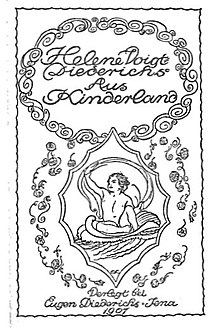Erich Kuithan

Erich Kuithan (born October 24, 1875 in Bielefeld , † December 30, 1917 in Jena ) was an expressionist German painter and director of a drawing school in Jena.
Life
Erich Kuithan was the third son of the silk manufacturer Emil Kuithan and his wife Antonie, nee Könemann. His eldest brother Walter became a doctor, while his brother Fritz also embarked on an artistic career. After the father's death in 1888, the family moved to Munich , where Erich Kuithan attended Ludwig Schmid-Reutte and Friedrich Fehr's private drawing school after graduating from high school in 1892 . From May 1893 he was accepted into the drawing class of Karl Raupp at the Academy of Fine Arts . In 1895 the family moved to Schliersee . Here Kuithan met Karl Haider , who strongly influenced his painting style. In the years that followed, Kuithan went on a number of study trips, exhibited at art associations, worked for the magazine Jugend and made illustrations for children's books.
From the winter of 1901/02 Kuithan was in Berlin and met Ludwig Pallat , who recommended him for the position of head of the free drawing school initiated by Siegfried Czapski and Ernst Abbe in the Volkshaus Jena . From July 1, 1903, Kuithan gave courses in drawing, painting and modeling there, until financial savings measures led to his resignation in 1908. In Jena he was a member of the newly founded local group of the Federation for Homeland Security (in addition to Ferdinand Avenarius , artists from Worpswede , Wilhelm Bölsche , Justus Brinckmann and others), was a frequent guest at cultural societies, which he also enjoyed with performances on the lute , and created numerous Paintings, drawings, illustrations, furniture, clothes, bookplates , porcelain service and frescoes (including in the Volkshaus and the main university building). He belonged to the close circle of friends of the publisher Eugen Diederichs , with whose wife Helene Voigt-Diederichs he had an affair. In 1910 Erich Kuithan traveled to Italy and in 1911 was offered a call to the Royal Art School in Berlin. In 1916 he returned to Jena due to an incurable illness and died there on December 30, 1917. In Jena, Erich-Kuithan-Strasse was named after him.
The drawing school
Kuithan's students included Hans Schlag (architect), Bruno Pflügner (sculptor), Gustav Mohr (art teacher), the painters Otto Herbig , Gotthilf Schall, Georg Kötschau, Alexe Franken, Clara Harnack and Helene Czapski . With the organization of exhibitions at the drawing school, he brought the visual arts into greater public awareness. After Erich Kuithan's resignation in 1908 and financial problems of the sponsor, the Carl Zeiss Foundation , the public called for the school to continue to exist , and Fritz Kuithan continued the courses for a while.
Painting style
In the early works, landscapes in dark colors were the focus. Later Kuithan increasingly used light Art Nouveau tones and, inspired by the humanistic ideas of Ernst Abbe, mainly created idealistic images of people in spring and beach motifs, in allegorical figures and in depictions of mother and child. The figures in his pictures were often shown in front of real landscapes of the Saale valley . In his later pictures strong, at times unmixed colors that show echoes of expressionism were predominant. In landscapes and figure paintings, Erich Kuithan developed a mysterious, spiritualized symbolism , probably also under the impression of his incurable disease , which conveys his longing for beauty and harmony.
Works and exhibitions (selection)
- Poster for the Schiller Memorial Exhibition for Aesthetic Culture . Jena, 1905
- Kuithan exhibition . Jena, February 20, 1907
- Illustrations for Helene Voigt-Diederichs' Aus Kinderland . Jena, 1907
- Illustrations for the glass industry in Jena. A work by Schott and Abbe . Jena, 1909
- Painting Spring in the Saale Valley , Jena 1908–1910 (Cover picture by Meike Werner: Modernism in the Province , Göttingen 2003)
- Painting Girl with Apples , Great Berlin Art Exhibition 1914
- Erich Kuithan 1875-1917. Paintings, studies, drawings . Exhibition in the Romantikerhaus Jena from September 12 to December 4, 1993.
- Erich Kuithan. Paintings and drawings . Art collection Jena , Jena 2017/2018.
literature
- Schmolitzky, Oskar: Erich Kuithan. A painter's fate at the beginning of the 20th century . Writings of the City Museum, Jena 1957
- Erich Kuithan 1875-1917. Paintings, studies, drawings . Catalog for the exhibition in the Romantikerhaus Jena from September 12 to December 4, 1993. Leipzig 1993
- Reitmeier, Harald: The painter Erich Kuithan. Life and work. With a critical catalog of the paintings and gouaches . Heidelberg 1995 (diss.)
- Schmid, Maria: Erich Kuithan and the free drawing school Jena - In John / Wahl (Hrsg.): Between convention and avant-garde. Weimar 1995
- Meike Werner: Modernism in the provinces: cultural experiments in the fin de siècle Jena ; Wallstein Verlag, Göttingen 2003. ISBN 3-89244-594-X
- Brückner, Ramona: Erich Kuithan. Art and industry in Jena in the early 20th century . (Ed .: Städtische Museen Jena). Weimar 2005
- The longing for beauty and harmony. Erich Kuithan and the free drawing school Jena - In: Schott in Jena. Jena 2005
Web links
- Literature by and about Erich Kuithan in the catalog of the German National Library
- ( Page no longer available , search in web archives: source for biography and works )
- Painting by Erich Kuithan
- Erich Kuithan's Adbkm register
Individual evidence
- ↑ Fig. In Art for All . 23/24 Issue, XXIX. vintage
| personal data | |
|---|---|
| SURNAME | Kuithan, Erich |
| BRIEF DESCRIPTION | German painter |
| DATE OF BIRTH | October 24, 1875 |
| PLACE OF BIRTH | Bielefeld |
| DATE OF DEATH | December 30, 1917 |
| Place of death | Jena |

